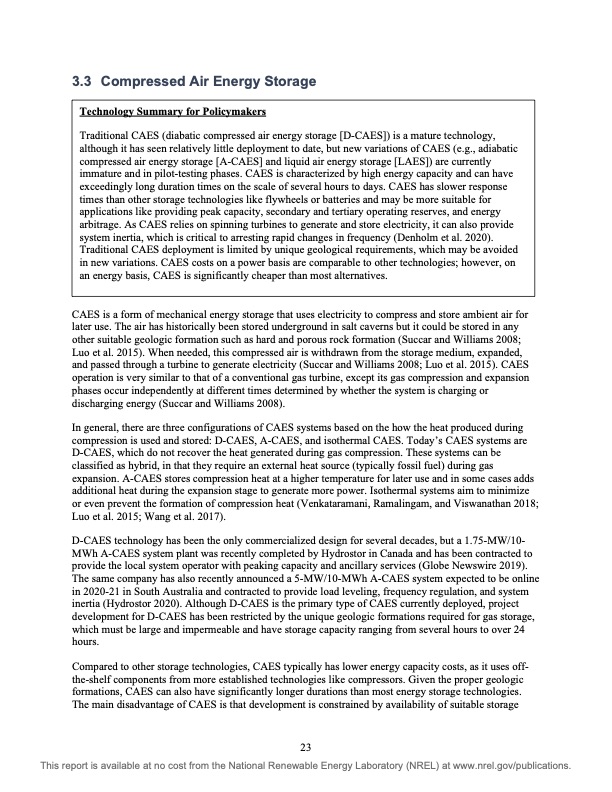
PDF Publication Title:
Text from PDF Page: 030
3.3 CompressedAirEnergyStorage Technology Summary for Policymakers Traditional CAES (diabatic compressed air energy storage [D-CAES]) is a mature technology, although it has seen relatively little deployment to date, but new variations of CAES (e.g., adiabatic compressed air energy storage [A-CAES] and liquid air energy storage [LAES]) are currently immature and in pilot-testing phases. CAES is characterized by high energy capacity and can have exceedingly long duration times on the scale of several hours to days. CAES has slower response times than other storage technologies like flywheels or batteries and may be more suitable for applications like providing peak capacity, secondary and tertiary operating reserves, and energy arbitrage. As CAES relies on spinning turbines to generate and store electricity, it can also provide system inertia, which is critical to arresting rapid changes in frequency (Denholm et al. 2020). Traditional CAES deployment is limited by unique geological requirements, which may be avoided in new variations. CAES costs on a power basis are comparable to other technologies; however, on an energy basis, CAES is significantly cheaper than most alternatives. CAES is a form of mechanical energy storage that uses electricity to compress and store ambient air for later use. The air has historically been stored underground in salt caverns but it could be stored in any other suitable geologic formation such as hard and porous rock formation (Succar and Williams 2008; Luo et al. 2015). When needed, this compressed air is withdrawn from the storage medium, expanded, and passed through a turbine to generate electricity (Succar and Williams 2008; Luo et al. 2015). CAES operation is very similar to that of a conventional gas turbine, except its gas compression and expansion phases occur independently at different times determined by whether the system is charging or discharging energy (Succar and Williams 2008). In general, there are three configurations of CAES systems based on the how the heat produced during compression is used and stored: D-CAES, A-CAES, and isothermal CAES. Today’s CAES systems are D-CAES, which do not recover the heat generated during gas compression. These systems can be classified as hybrid, in that they require an external heat source (typically fossil fuel) during gas expansion. A-CAES stores compression heat at a higher temperature for later use and in some cases adds additional heat during the expansion stage to generate more power. Isothermal systems aim to minimize or even prevent the formation of compression heat (Venkataramani, Ramalingam, and Viswanathan 2018; Luo et al. 2015; Wang et al. 2017). D-CAES technology has been the only commercialized design for several decades, but a 1.75-MW/10- MWh A-CAES system plant was recently completed by Hydrostor in Canada and has been contracted to provide the local system operator with peaking capacity and ancillary services (Globe Newswire 2019). The same company has also recently announced a 5-MW/10-MWh A-CAES system expected to be online in 2020-21 in South Australia and contracted to provide load leveling, frequency regulation, and system inertia (Hydrostor 2020). Although D-CAES is the primary type of CAES currently deployed, project development for D-CAES has been restricted by the unique geologic formations required for gas storage, which must be large and impermeable and have storage capacity ranging from several hours to over 24 hours. Compared to other storage technologies, CAES typically has lower energy capacity costs, as it uses off- the-shelf components from more established technologies like compressors. Given the proper geologic formations, CAES can also have significantly longer durations than most energy storage technologies. The main disadvantage of CAES is that development is constrained by availability of suitable storage 23 This report is available at no cost from the National Renewable Energy Laboratory (NREL) at www.nrel.gov/publications.PDF Image | USAID GRID-SCALE ENERGY STORAGE TECHNOLOGIES PRIMER

PDF Search Title:
USAID GRID-SCALE ENERGY STORAGE TECHNOLOGIES PRIMEROriginal File Name Searched:
76097.pdfDIY PDF Search: Google It | Yahoo | Bing
Turbine and System Plans CAD CAM: Special for this month, any plans are $10,000 for complete Cad/Cam blueprints. License is for one build. Try before you buy a production license. More Info
Waste Heat Power Technology: Organic Rankine Cycle uses waste heat to make electricity, shaft horsepower and cooling. More Info
All Turbine and System Products: Infinity Turbine ORD systems, turbine generator sets, build plans and more to use your waste heat from 30C to 100C. More Info
CO2 Phase Change Demonstrator: CO2 goes supercritical at 30 C. This is a experimental platform which you can use to demonstrate phase change with low heat. Includes integration area for small CO2 turbine, static generator, and more. This can also be used for a GTL Gas to Liquids experimental platform. More Info
Introducing the Infinity Turbine Products Infinity Turbine develops and builds systems for making power from waste heat. It also is working on innovative strategies for storing, making, and deploying energy. More Info
Need Strategy? Use our Consulting and analyst services Infinity Turbine LLC is pleased to announce its consulting and analyst services. We have worked in the renewable energy industry as a researcher, developing sales and markets, along with may inventions and innovations. More Info
Made in USA with Global Energy Millennial Web Engine These pages were made with the Global Energy Web PDF Engine using Filemaker (Claris) software.
Sand Battery Sand and Paraffin for TES Thermo Energy Storage More Info
| CONTACT TEL: 608-238-6001 Email: greg@infinityturbine.com | RSS | AMP |